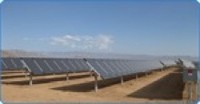 At 1 MW, Wal-Mart Completes its Largest Solar Array to DateJan 19, 2010 - Environmental Leader
The ground-mounted installation covers about seven acres and provides sufficient power for the equivalent of 175 homes, reports GetSolar. The panels will provide enough power for about 20 percent of the energy needs of the 1.3 million square foot distribution center, reports the High Desert Daily Press. Earlier this month, Wal-Mart completed three more solar projects in California, bringing the giant retailer closer to its goal of using 100 percent renewable energy Here is a fact sheet about Wal-Mart’s solar power use. Here’s another for wind energy. Wal-Mart launched a solar pilot program in May 2007 followed by an expanded initiative on Earth Day 2009, which should double the retailer’s use of solar energy in California, adding solar installations at 10 to 20 facilities over the next 12 months. The total solar effort across the state is expected to generate up to 32 gigawatt-hours of energy each year, while helping to avoid more than 10,000 metric tons of carbon-dioxide emissions each year, and providing 20 to 30 percent of each facility’s electric needs. |
Updated: 2003/07/28
 More than 5,300 solar panels at Wal-Mart’s Apple Valley distribution center in California will generate about a megawatt of electricity, reports
More than 5,300 solar panels at Wal-Mart’s Apple Valley distribution center in California will generate about a megawatt of electricity, reports